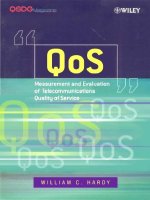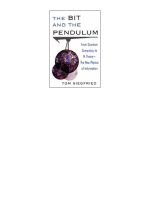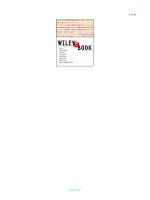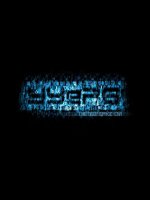John wiley sons uwb signals and systems in communication engineering ghavami2004
Bạn đang xem bản rút gọn của tài liệu. Xem và tải ngay bản đầy đủ của tài liệu tại đây (4.93 MB, 278 trang )
Ultra Wideband
Signals and Systems
in Communication
Engineering
M. Ghavami
King’s College London, UK
L. B. Michael
Japan
R. Kohno
Yokohama National University, Japan
John Wiley & Sons, Ltd
Ultra Wideband
Signals and Systems
in Communication
Engineering
Ultra Wideband
Signals and Systems
in Communication
Engineering
M. Ghavami
King’s College London, UK
L. B. Michael
Japan
R. Kohno
Yokohama National University, Japan
John Wiley & Sons, Ltd
Copyright © 2004
John Wiley & Sons, Ltd,
The Atrium, Southern Gate, Chichester,
West Sussex, PO19 8SQ, England
Telephone
01243 779777
E-mail (for orders and customer service enquiries):
Visit our Home Page on www.wileyeurope.com or www.wiley.com
All Rights Reserved. No part of this publication may be reproduced, stored in a retrieval
system or transmitted in any form or by any means, electronic, mechanical, photocopying,
recording, scanning or otherwise, except under the terms of the Copyright, Designs and
Patents Act 1988 or under the terms of a licence issued by the Copyright Licensing Agency
Ltd, 90 Tottenham Court Road, London W1T 4LP, UK, without the permission in writing of
the Publisher. Requests to the Publisher should be addressed to the Permissions Department,
John Wiley & Sons Ltd, The Atrium, Southern Gate, Chichester, West Sussex, PO19 8SQ,
England, or e-mailed to , or faxed to (+44) 1243 770620.
This publication is designed to provide accurate and authoritative information in regard to
the subject matter covered. It is sold with on the understanding that the Publisher is not
engaged in rendering professional services. If professional advice or other expert assistance
is required, the services of a competent professional should be sought.
Other Wiley Editorial Offices
John Wiley & Sons, Inc., 111 River Street, Hoboken, NJ 07030, USA
Jossey-Bass, 989 Market Street, San Francisco, CA 94103-1741, USA
Wiley-VCH Verlag GmbH, Boschstr. 12, D-69469 Weinheim, Germany
John Wiley & Sons Australia Ltd, 33 Park Road, Milton, Queensland 4064, Australia
John Wiley & Sons (Asia) Pte Ltd, 2 Clementi Loop #02-01, Jin Xing Distripark,
Singapore 129809
John Wiley & Sons (Canada) Ltd, 22 Worcester Road, Etobicoke, Rexdale, Ontario,
Canada M9W 1L1
Wiley also publishes its books in a variety of electronic formats. Some content that appears
in print may not be available in electronic books.
British Library Cataloguing in Publication Data
A catalogue record for this book is available from the British Library
ISBN 0-470-86751-5
Typeset by the author using LaTex Software.
Printed and bound in Great Britain by Antony Rowe, Chippenham, Wiltshire.
This book is printed on acid-free paper responsibly manufactured from sustainable forestry
in which at least two trees are planted for each one used for paper production.
Contents
Preface
xiii
Acknowledgments
xvii
List of Figures
xix
List of Tables
1
xxvii
Introduction
I.1 Ultra wideband overview
I.2 A note on terminology
I.3 Historical development of UWB
I.4 Key benefits of UWB
I.5 UWB and Shannon’s theory
I.6 Challenges for ultra wideband
I.7 Summary
1
1
2
2
3
4
5
6
Basic properties of UWB signals and systems
1.1 Introduction
1.2 Power spectral density
1.3 Pulse shape
7
7
8
9
v
vi
CONTENTS
1.4
1.5
1.6
1.7
1.8
1.9
1.10
1.11
1.12
1.13
Pulse trains
Spectral masks
Multipath
Penetration characteristics
Spatial and spectral capacities
Speed of data transmission
Cost
Size
Power consumption
Summary
11
13
15
18
19
20
21
21
22
22
2
Generation of ultra wideband waveforms
2.1 Introduction
2.1.1 Damped sine waves
2.2 Gaussian waveforms
2.3 Orthogonal waveforms and Hermite pulses
2.3.1 Hermite polynomials
2.3.2 Orthogonal modified Hermite pulses
2.3.3 Modulated and modified Hermite pulses
2.4 Orthogonal prolate spheroidal wave functions
2.4.1 Introduction
2.4.2 Fundamentals of PSWF
2.4.3 PSWF pulse generator
2.5 Designing waveforms for specific spectral masks
2.5.1 Introduction
2.5.2 Multi-band modulation
2.6 Practical constraints and effects of imperfections
2.7 Summary
25
25
26
28
31
32
33
37
39
40
41
45
49
49
50
57
59
3
Signal-processing techniques for UWB systems
3.1 The effects of lossy medium on an UWB transmitted
signal
3.2 Time domain analysis
3.2.1 Classification of signals
3.2.2 Some useful functions
3.2.3 Some useful operations
3.2.4 Classification of systems
63
63
66
67
69
71
76
CONTENTS
3.3
3.4
3.5
3.6
4
3.2.5 Impulse response
3.2.6 Distortionless transmission
Frequency domain techniques
3.3.1 Fourier transforms
3.3.2 Frequency response approaches
3.3.3 Transfer function
3.3.4 Laplace transform
3.3.5 z -Transform
3.3.6 The relationship between the Laplace
transform, the Fourier transform, and
the z -transform
UWB signal-processing issues and algorithms
Detection and amplification
Summary
Ultra wideband channel modeling
4.1 A simplified UWB multipath channel model
4.1.1 Number of resolvable multipath components
4.1.2 Multipath delay spread
4.1.3 Multipath intensity profile
4.1.4 Multipath amplitude-fading distribution
4.1.5 Multipath arrival times
4.2 Path loss model
4.2.1 Free space loss
4.2.2 Refraction
4.2.3 Reflection
4.2.4 Diffraction
4.2.5 Wave clutter
4.2.6 Aperture-medium coupling loss
4.2.7 Absorption
4.2.8 Example of free space path loss model
4.3 Two-ray UWB propagation model
4.3.1 Two-ray path loss
4.3.2 Two-ray path loss model
4.3.3 Impact of path loss frequency selectivity on
UWB transmission
vii
77
78
78
78
79
81
84
85
88
89
91
93
97
98
100
100
102
102
103
106
106
106
107
107
108
108
108
108
110
111
114
117
viii
CONTENTS
4.4
4.5
5
Frequency domain autoregressive model
4.4.1 Poles of the AR model
Summary
Ultra wideband communications
5.1 Introduction
5.2 UWB modulation methods
5.2.1 Pulse position modulation
5.2.2 Bi-phase modulation
5.3 Other modulation methods
5.3.1 Orthogonal pulse modulation
5.3.2 Pulse amplitude modulation
5.3.3 On-off keying
5.3.4 Summary of UWB modulation methods
5.4 Pulse trains
5.4.1 Gaussian pulse train
5.4.2 PN channel coding
5.4.3 Time-hopping PPM UWB system
5.5 UWB transmitter
5.6 UWB receiver
5.6.1 Detection
5.6.2 Pulse integration
5.6.3 Tracking
5.6.4 Rake receivers
5.7 Multiple access techniques in UWB
5.7.1 Frequency division multiple access UWB
5.7.2 Time division multiple access
5.7.3 Code division multiple access
5.7.4 Orthogonal pulse multiple access system
5.8 Capacity of UWB systems
5.9 Comparison of UWB with other wideband
communication systems
5.9.1 CDMA
5.9.2 Comparison of UWB with DSSS and FHSS
5.9.3 Orthogonal frequency division multiplexing
5.10 Interference
5.10.1 Wireless local area networks
121
122
123
125
125
126
128
129
130
130
132
132
132
133
133
134
136
137
138
139
140
140
140
140
141
141
141
142
144
146
147
148
151
152
154
CONTENTS
6
ix
5.10.2 Bluetooth
5.10.3 GPS
5.10.4 Cellular systems
5.11 Summary
157
158
159
159
Ultra wideband antennas and arrays
6.1 Antenna fundamentals
6.1.1 Maxwell’s equations for free space
6.1.2 Wavelength
6.1.3 Antenna duality
6.1.4 Impedance matching
6.1.5 VSWR and reflected power
6.1.6 Antenna bandwidth
6.1.7 Directivity and gain
6.1.8 Antenna field regions
6.1.9 Antenna directional pattern
6.1.10 Beamwidth
6.2 Antenna radiation for UWB signals
6.2.1 Dispersion due to near-field effects
6.3 Suitability of conventional antennas for the UWB
system
6.3.1 Resonant antennas
6.3.2 Nonresonant antennas
6.3.3 Difficulties with UWB antenna design
6.4 Impulse antennas
6.4.1 Conical antenna
6.4.2 Monopole antenna
6.4.3 D-dot probe antenna
6.4.4 TEM horn antenna
6.4.5 Conclusion
6.5 Beamforming for UWB signals
6.5.1 Basic concepts
6.5.2 A simple delay-line transmitter wideband
array
6.6 Radar UWB array systems
6.7 Summary
161
162
162
164
165
165
165
165
166
166
166
168
169
172
173
173
176
176
177
177
178
179
179
180
181
181
184
190
191
x
CONTENTS
7
Position and location with ultra wideband signals
7.1 Wireless positioning and location
7.1.1 Types of wireless positioning systems
7.1.2 Wireless distance measurement
7.1.3 Microwave positioning systems
7.2 Global positioning system techniques
7.2.1 Differential GPS (DGPS)
7.2.2 GPS tracking modes
7.2.3 GPS error sources
7.3 Positioning techniques
7.3.1 Introduction
7.3.2 Network-based techniques
7.3.3 Handset-based techniques
7.3.4 Hybrid techniques
7.3.5 Other techniques
7.4 Time resolution issues
7.4.1 Narrowband systems
7.4.2 Wideband systems
7.4.3 Super-resolution techniques
7.4.4 Ultra wideband systems
7.5 UWB positioning and communications
7.5.1 Potential user scenarios
7.5.2 Potential applications
7.6 Summary
193
193
194
194
196
199
200
200
201
201
201
202
208
209
210
210
210
210
211
214
216
216
217
218
8
Applications using ultra wideband systems
8.1 Military applications
8.1.1 Precision asset location system
8.2 Commercial applications
8.2.1 Time Domain PulsON 200
8.2.2 Time Domain UWB signal generator
8.2.3 XtremeSpectrum
8.2.4 Intel corporation
8.2.5 Motorola
8.2.6 Communication Research Laboratory
8.2.7 General atomics
8.2.8 Wisair
221
221
222
223
224
224
225
225
226
227
228
228
CONTENTS
8.3
8.2.9 Home networking and home electronics
8.2.10 Precision asset location system
Summary
xi
229
230
233
References
235
Index
242
Preface
In this book we focus on the basic signal processing that underlies current and
future ultra wideband systems. By looking at signal processing in this way we
hope this text will be useful even as UWB applications mature and change or
regulations regarding ultra wideband systems are modified. The current UWB
field is extremely dynamic, with new techniques and ideas being presented at every
communications and signal-processing conference. The basic signal-processing
techniques presented in this text though will not change for some time to come.
Thus, we have taken a somewhat theoretical approach, which we believe is longer
lasting and more useful to the reader in the long term than an up-to-the-minute
summary that is out of date as soon as it is published.
We restrict our discussion in general to ultra wideband communication, looking
in particular at consumer communication. What we mean by this is that although
there are many and varied specialized applications for UWB, particularly for the
military, we assume that the majority of readers will either be in academia or in
industry. In any case, as this is a basic text aimed primarily at the undergraduate
or graduate student, these basics should stand readers in good stead in their
efforts to understand more advanced papers and make a contribution in this field
for themselves. We are painfully aware of the depth and breadth of this field
and, regretfully, pass on interesting topics, such as UWB radar, including groundpenetrating radar, and most military applications. For the former there is already
a great deal of information available, while for the latter most material is classified.
xiii
xiv
PREFACE
The introduction to this book presents a brief look at why UWB is considered to
be such an exciting wireless technology for the near future. We examine Shannon’s
famous capacity equation and, as a consequence, look at the large-bandwidth
possibilities for high data rate communication.
Chapter 1 presents the basic properties of UWB. We examine the power spectral
density, basic pulse shape, and spectral shape of these pulses. The regulatory
requirements laid down by the FCC are briefly described. Why UWB is considered
to be a multipath-resistant form is also examined, and such basic features of merit
such as capacity and speed of data transmission are considered. We finish the
chapter with a look at the cost, size, and power consumption that is forecast for
UWB devices and chipsets.
Chapter 2 examines in detail how to generate pulse waveforms for UWB systems, for both simple cases, such as the Gaussian pulse shape, and more complex
orthogonal pulses. We examine the possibility of designing pulses to fit spectral
masks, such as mandated by regulators, or to avoid interference with other frequency bands. We finish the chapter with a look at some practical constraints and
the effects of imperfections on these designer pulse shapes.
Chapter 3 looks at different signal-processing techniques for UWB systems. The
chapter begins with a review of basic signal-processing techniques, including both
time and frequency domain techniques. The Laplace, Fourier, and z-transforms
are reviewed and their application to UWB is discussed. Finally, some practical
issues, such as pulse detection and amplification, are discussed.
The wireless indoor channel and how it should be modeled for UWB communications is considered in Chapter 4. Following our basic pattern we define and
explore the basic concepts of wideband channel modeling and show a simplified
UWB multipath channel model that is amenable to both theoretical analysis and
simulation. Path loss effects and a two-ray model are presented. Finally, the
frequency domain autoregressive model is discussed.
Chapter 5 takes a look at some of the fundamental communication concepts
and how they should be applied to UWB. First, modulation methods applicable
to UWB are presented. A basic communication system consisting of transmitter,
receiver, and channel is discussed. Since most consumer communication systems
do not consist of only one user, multiple access techniques are introduced. The
simple capacity of a UWB system is derived. Since other wireless consumer communication systems have already become popular, a comparison between UWB
and other wideband techniques is included. Finally, the chapter ends with a look
at interference to and from UWB systems.
Chapter 6 is concerned with ultra wideband antennas and arrays of antennas.
This is considered one of the most difficult problems that must be overcome before
the widespread commercialization of UWB devices takes place. Antenna fundamentals are first introduced, including Maxwell’s equations for free space, antenna
field regions, directivity, and gain. The suitability of conventional antennas for
UWB transmission and reception is discussed in detail. More suitable impulse
PREFACE
xv
antennas are then introduced. Arrays of antennas and beamforming for UWB
systems are given a brief treatment.
Positioning and location using both traditional techniques and UWB is discussed in Chapter 7. Traditional location systems are first introduced and their
pros and cons discussed. The advantages of UWB, particularly the extremely
precise positioning that is theoretically possible, is examined. Finally, several
possible scenarios are discussed where the precise location capabilities and high
data rate of UWB can be combined to produce some new and exciting applications.
Chapter 8 concludes the book with a brief look at some current applications
that use UWB technology, as well as an overview of some current chipsets and possible future UWB products. Emphasis is on consumer communication; however,
military applications are given a brief treatment.
For the reader who wants a fast-track understanding of UWB and some knowledge of the current situation, we recommend the introduction, Chapter 1 (Basic
properties of UWB signals and systems), and Chapter 8 (Applications).
For students who want to look at UWB in more detail, they should then proceed
to look at Chapters 2 (The generation of UWB waveforms), Chapter 3 (Signal
processing techniques for UWB systems) and then Chapters 4 through to 7 as
required; in other words, the entire book with the possible exception of Chapter 8.
We have strived to make each chapter complete in itself as far as possible and
provide as much basic theory as possible, including derivations where appropriate.
We have made constant reference to the literature, a significant part of which is
covered here.
As an extra resource we have set up a companion website for our book containing
a solutions manual, matlab programs for the examples and problems, and a sample
chapter. Also, for those wishing to use this material for lecturing purposes,
electronic versions of most of the figures from our book are available. Please
go to the following URL and take a look: ftp://ftp/pub/books/ghavami:uwb
We hope that you will find this book useful as both a reference, a learning tool,
and a stepping stone to further your own efforts in this exciting field.
M. Ghavami
L. B. Michael
R. Kohno
London, May 2004
Acknowledgments
The authors would like to thank the following for their efforts and contributions
to Ultra Wideband Signals and Systems in Communication Engineering:
Sarah Hinton, our editor, for her tireless and unending efforts to make this
publication timely and well received, as well as for helping us with the ins and
outs of writing a textbook.
Professor Hamid Aghvami, the director of the Centre for Telecommunications
Research, London, for providing a rich research environment and for his encouragement during the preparation of the book.
Dr. Mario Tokoro of Sony Computer Science Laboratories, Tokyo, for providing
a free research environment to explore new ideas. It was here that the authors first
began to study ultra wideband signals and systems and their applications and the
idea for this book was born.
The following made valuable contributions by reviewing and in some cases
contributing material to the book:
Dr. B. Allen (King’s College London)
S. Ciolino (King’s College London)
R. S. Dilmaghani (King’s College London)
D. Karveli (King’s College London)
S. McGregor (King’s College London)
C. Mitchell (Yokohama National University)
Dr. T. Otsuki (Tokyo University of Science)
xvii
xviii
In addition, S. Ciolino and R. S. Dilmaghani of King’s College London helped
to contribute material to this book.
M. Ghavami would like to thank:
my wife and my children who have suffered the long period of preparation
of this book and who have been continually supportive.
L. B. Michael would like to thank:
my wife and children for their support and patience during the weekends
and nights while I was preparing and editing material for this book.
List of Figures
1.1
Low-energy density and high-energy density systems.
1.2
(a) Idealized received UWB pulse shape wrx and
(b) idealized spectrum of a single received UWB pulse. 10
1.3
A simple Matlab circuit model to create the Gaussian
doublet.
11
Details of the pulses generated in a typical UWB
communication system: (a) square pulse train;
(b) Gaussian-like pulses; (c) first-derivative pulses;
(d) received Gaussian doublets.
12
(a) UWB pulse train and (b) spectrum of a UWB
pulse train.
13
Spectrum of a pulse train which has been “dithered”
by shifting pulses forward and back of the original
position.
14
Spectral mask mandated by FCC 15.517(b,c) for
indoor UWB systems.
15
1.4
1.5
1.6
1.7
9
xix
xx
LIST OF FIGURES
1.8
1.9
A typical indoor scenario in which the transmitted
pulse is reflected off objects within the room, thus
creating multiple copies of the pulse at the receiver,
with different delays.
16
Two pulses arriving with a separation greater than
the pulse width will not overlap and will not cause
interference.
17
1.10 (a) Two overlapping UWB pulses, and (b) the
received waveform consisting of the overlapped pulses.
18
2.1
Damped sine waves and their Fourier transforms.
27
2.2
A Gaussian pulse, monocycle, and doublet in time
and frequency domains. The Gaussian pulse has a
large DC component.
30
Time and frequency responses of the normalized
MHP of orders n = 0, 1, 2, 3 normalized to unit energy.
36
Autocorrelation functions of modified normalized
Hermite pulses of orders n = 0, 1, 2, 3. The width
of the main peak in the autocorrelation function
becomes narrower as the order of the pulse increases.
38
Time and frequency representations of pn (t) for
orders n = 0, 1, 2, 3. All pulses have zero low-frequency
components. Compared with Figure 2.3(a) the
number of zero crossings has been increased. It can
also be seen that the fractional bandwidth of the
signals has reduced from 200% to about 100% and
can be further reduced by increasing fc .
39
The analog linear time-variant circuit producing
different pn (t) functions.
40
Schematic diagram of a UWB communication system
employing a PSWF pulse generator.
45
Schematic diagram of four different PSWF pulse
generators.
47
Output of the (a) fourth and (b) fifth-order PSWF
generators.
48
2.3
2.4
2.5
2.6
2.7
2.8
2.9
2.10 Schematic diagram of the PSWF UWB receiver.
49
LIST OF FIGURES
xxi
2.11 A modulated Gaussian pulse and its frequency
domain presentation. The centre frequency is 4 GHz.
52
2.12 A combination of five modulated Gaussian pulses
and its frequency domain presentation.
54
2.13 A combination of four modulated Gaussian pulses
and its frequency domain presentation after removing
the 5-GHz band for interference mitigation.
55
2.14 Deeper null produced by changing the number of
bands and the parameter of the Gaussian pulse used
for wave shaping.
57
2.15 A combination of four delayed modulated Gaussian
pulses and its frequency domain presentation after
removing the 5-GHz band for interference mitigation.
58
3.1
Regions including the source and lossy medium for
calculations of the electric and magnetic fields of a
UWB signal.
64
3.2
Propagation of electric and magnetic fields.
66
3.3
Examples of (a) continuous time and (b) discrete
time UWB signals.
68
3.4
Unit impulse function δ(t).
69
3.5
Unit step function u(t).
70
3.6
Sinc function.
71
3.7
Convolution of a rectangular waveform with an
exponential waveform.
75
Representation of a system with input x(t) and output
y(t).
76
Conditions for a system to be linear.
76
3.8
3.9
3.10 Signals associated with a causal system.
77
3.11 Time-invariant system.
77
3.12 A simple two-stage RC circuit and its time and
frequency response for R = 10 Ω and C = 10 pF.
83
3.13 Two discrete time exponential functions h1 (n) and
h2 (n) for a = 0.9.
87
xxii
LIST OF FIGURES
3.14 Block diagram of a simple digital UWB receiver.
90
3.15 The structure of the received and template signals.
92
3.16 Operations necessary for demodulation of a UWB
signal.
92
3.17 Pulses for Problem 2.
94
4.1
4.2
4.3
4.4
4.5
4.6
4.7
4.8
4.9
A simple model of the indoor UWB radio multipath
channel.
99
Typical exponential delay profile with total and rms
delay spread.
101
Illustration of the modified Poisson process in the
continuous case.
104
Illustration of the modified Poisson process in the
discrete case.
105
Geometry of the two-ray model including a
transmitter and a receiver.
111
Path loss versus distance and frequency: hT = 2.5 m,
hR = 1.2 m, and RV = 1.
114
Path loss distance slope coefficient γ(f ) and mean
value γ , 3 GHz ≤ f ≤ 10 GHz, hT = 2.5 m, hR = 1.2
m: (a) 1 m ≤ d ≤ 3.5 m, γl = 1.32; (b) 3.5 m ≤ d ≤ 10 m,
γu = 1.9.
116
Path loss frequency slope coefficient ν(d) and mean
value ν = 2 for 1 m ≤ d ≤ 10 m, hT = 2.5 m, and
hR = 1.2 m.
117
Path loss versus distance for 1 m ≤ d ≤ 10 m,
f = 5 GHz , hT = 2.5 m, and hR = 1.2 m.
118
4.10 Path loss versus frequency for 3 GHz ≤ f ≤ 10 GHz,
d = 2 m, hT = 2.5 m and hR = 1.2 m.
119
4.11 Impact of path loss frequency selectivity on UWB
signal waveforms: (a) normalized impulse response;
(b) transmitted pulse waveform; (c) received pulse
waveform.
120
4.12 Implementation of an AR model using an IIR
formulation.
123









